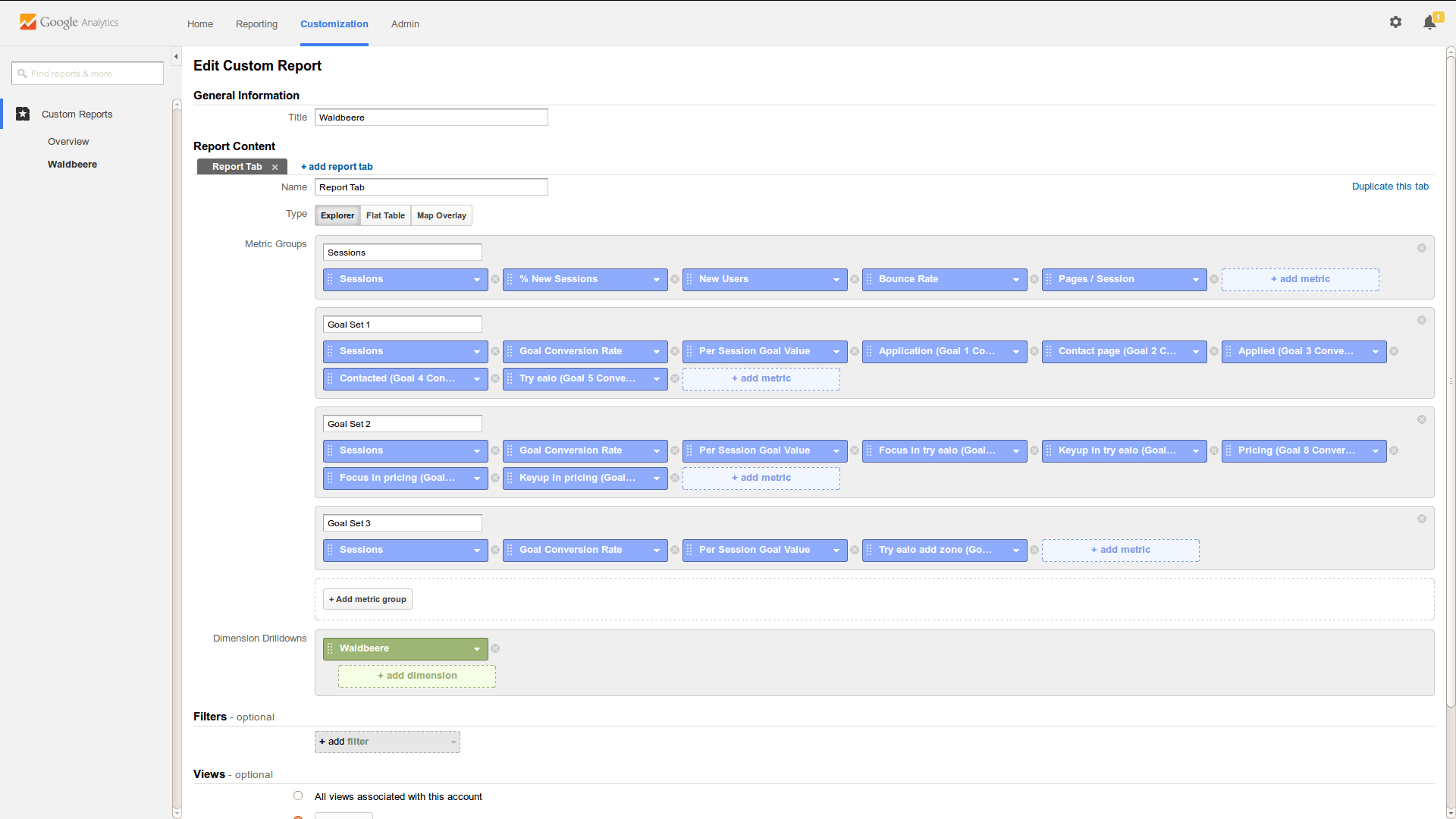Waldbeere is a tiny JavaScript to run AB and Multivariate Split Tests.
Waldbeere is less than 1 KB when gzip compressed and integrates seamlessly with Google Analytics. Contrary to other AB and Multivariate test tools, Waldeere does not slow down your website -- there are no extra DNS or HTTP requests when using Waldbeere.
- Supports both AB and Multivariate tests.
- Unlimited number of users.
- Does not slow down your website.
- Can run tests with or without control.
- Free.
- No GUI.
- No data analysis.
- Set up goals in Google Analytics.
- Set up a custom dimension in Google Analytics.
- Get the script and add it before the end of your page's <head>.
- Set up your tests.
- Send the Waldbeere.customVar property to Google Analytics as a custom dimension.
- Watch the data pour in.
- ???
- Feel like a marketing guru and PROFIT.
Before using Waldbeere, you need to have goals set up in Google Analytics that you want to optimize the conversion rate of. How to is a bit outside the scope of this README.md, but some things you can set up as goals are
- "Thank you" pages shown after placing an order
- Subscribing to an email newsletter
- Interacting with a video
- Donating to a website
Go to your profile, click "Admin" and then "Custom Definitions" on the property level. Select "Custom Dimensions" and set up a custom dimension as follows:
Note the index of the custom dimension as you'll need it later for the integration with analytics.js.
Copy & paste this stub before the end of your page's <head>.
<head>
<title>...</title><script>
(function(r,l){try{var t=function(a,w){return s(a)+":"+s(w)},s=function(a){n.lastIndex=0;return n.test(a)?'"'+a.replace(n,function(a){var b=x[a];return"string"===typeof b?b:"\\u"+("0000"+a.charCodeAt(0).toString(16)).slice(-4)})+'"':'"'+a+'"'},u=function(a,c,b){var e,d;if("undefined"!=typeof c){b=b||{};null===c&&(c="");e=b.path;if(b=b.expires)d=new Date,d.setTime(d.getTime()+864E5*b),d="; expires="+d.toUTCString();document.cookie=[a,"=",encodeURIComponent(c),e?"; path="+e:"",d||""].join("")}else if(e=
document.cookie)if(b=e.indexOf(a+"="),-1<b)return d=e.indexOf(";",b),decodeURIComponent(e.substring(b+a.length+1,0>d?e.length:d))},n=/[\\\"\x00-\x1f\x7f-\x9f\u00ad\u0600-\u0604\u070f\u17b4\u17b5\u200c-\u200f\u2028-\u202f\u2060-\u206f\ufeff\ufff0-\uffff]/g,x={"\b":"\\b","\t":"\\t","\n":"\\n","\f":"\\f","\r":"\\r",'"':'\\"',"\\":"\\\\"},g=r[l]=r[l]||{},c,h={},m=[],a,f,k,p,q,v=function(){c=g.tests;if(a=u(l))for(a in q=eval("({"+a+"})"),q)f=q[a],!c[a]||!c[a][f]&&f||(h[a]=c[a][f]||"",m.push(t(a,f)));for(a in c)if(!h[a]&&
""!==h[a]){k=[];for(f in c[a])k.push(f);p=!g.config.noDefault&&1>Math.random()*(k.length+1)?"":k[Math.floor(Math.random()*k.length)];h[a]=c[a][p];m.push(t(a,p))}m.sort();g.customVar=m.join(",");u(l,g.customVar,g.config)};g.section=function(a){v();v=eval;h[a]&&document.write(h[a]+"<noscript>")}}catch(y){}})(window,"Waldbeere");
</script>
<script>
Waldbeere = window.Waldbeere || {};
Waldbeere.config = Waldbeere.config || {};
Waldbeere.config.expires = 30;
Waldbeere.config.path = '/';
Waldbeere.tests = {
};
</script></head>
<body>Waldbeere tests run in a section, which is the part of the page that you want to modify. You can modify
- text
- HTML
- CSS
A section may have a default that your tests will compare against. This is called a control.
If you only use one section, you are running an AB(CD...) test, if you use multiple sections, you are running a multivariate test.
Use this if you want to test different texts, for example on a button.
Waldbeere.tests = {
'buttontext': {
'funksoul': 'Check it out now',
'30 % off': '30 % off today!'
}
};The original button:
<button>Click here</button>With the Waldbeere split test:
<button><script>try{Waldbeere.section('buttontext');}catch(e){}</script>Click here</noscript></button>When Waldbeere is run by the browser, the text on the button may be replaced by "Check it out now" or "30 % off today!" In 33 % of all visits, "Click here" (the control) will be shown.
With Waldbeere, you can AB test entire parts of your page to optimize your conversion rates.
Waldbeere.tests = {
'addtocart': {
'free shipping': '<button>Add to cart<\/button><br><small>Shipping is free<\/small>',
'cart image': '<button><img src="cart.png"> Add to cart<\/button>'
}
};<script>try{Waldbeere.section('addtocart');}catch(e){}</script>
<button>Add to cart</button>
</noscript>Manipulating CSS is very effective because it allows to you make large, site-wide changes and see how your conversion rates change in response. Don't be afraid to test seemingly irrelevant things like background colours, link colours, font sizes or spacing between elements.
In this example, we're creating a multivariate test with 9 variations.
Waldbeere.tests = {
'font-size': {
'13': '<style>html,body { font-size: 13px }<\/style>',
'11': '<style>html,body { font-size: 11px }<\/style>'
},
'a': {
'00f': '<style>a { color: #00f }<\/style>',
'08c': '<style>a { color: #08c }<\/style>'
}
};Before the end of your page's <head>:
<script>try{Waldbeere.section('font-size');}catch(e){}</script></noscript>
<script>try{Waldbeere.section('a');}catch(e){}</script></noscript>When the page is loaded, you may see 11 or 13 px body text and different link colours.
After setting up Waldbeere and your creatings tests, you need to get the variation that's chosen by Waldbeere into Google Analytics. There, the combinations will show up in the Custom Variables or Custom Dimension reports.
If you use ga.js with the old syntax:
// var tracker = _gat._createTracker("UA-......-..","t")
if (window.Waldbeere && window.Waldbeere.customVar) {
tracker._setCustomVar(1, 'Waldbeere', Waldbeere.customVar, 2);
}
// tracker._trackPageview();If you use ga.js with the asynchronous syntax:
_gaq.push(
['_setAccount', 'UA-......-..'],
['_setCustomVar', 1, window.Waldbeere && window.Waldbeere.customVar ? 'Waldbeere' : null, window.Waldbeere && window.Waldbeere.customVar ? window.Waldbeere.customVar : null, 2 ],
['_trackPageview']
);If you use analytics.js:
ga('create', 'UA-......-..');
if (window.Waldbeere && window.Waldbeere.customVar) {
ga('set', 'dimension1', Waldbeere.customVar);
}
ga('send', 'pageview');Don't forget to use the dimension index from the custom dimensions setup above.
In Google Analytics, create a custom report using the Waldbeere custom dimension.
Delete your Waldbeere cookie and reload your page (a better method may come some day).
Keep your section and variation names short.
- Calculate the number of variations -- multiply the number of each section's variations (plus one if using control) together.
- Go here and enter your current conversion rate, the number of variations and the average number of daily visitors.
- Click "Calculate Test Duration."
- When you have no traffic.
- When your conversion rate is very low (think 1 % or less)
- When your conversion rate is very high (60 % or more)
Put both designs on the same page, wrapped in <div>s. Then, toggle the CSS display of both designs.
Waldbeere.tests = {
'designs': {
'2': '<style>#design1 { display: none } #design2 { display: block !important }<\/style>'
}
};
</script>
<script>try{Waldbeere.section('designs');}catch(e){}</script></noscript><div id="design1">
<h1>Welcome</h1>
<p>Bla</p>
</div>
<div id="design2" style="display: none">
<h1>Hey there</h1>
<p><img src="foo.jpg"></p>
</div>Use noDefault = 1 in the Waldbeere config.
<script>
Waldbeere = window.Waldbeere || {};
Waldbeere.config = Waldbeere.config || {};
Waldbeere.config.expires = 30;
Waldbeere.config.path = '/';
Waldbeere.config.noDefault = 1;
Waldbeere.tests = {
};
</script>I used and liked Google Website Optimizer a lot. When Google closed it, I wrote Waldbeere because I couldn't afford any of the popular split testing tools. I now run EAIO which is based on ideas that this script was used extensively for.
This (though it contains high-fructose corn syrup so beware).

